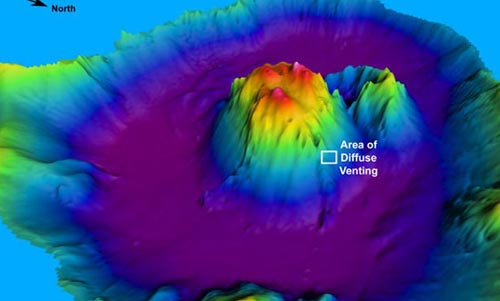 |
N. Oregon Coast Presentation Features Underwater Volcanoes
Published 03/05/2014

(Cannon Beach, Oregon) – Those wild, weird and wonderful undersea volcanoes will show up in Cannon Beach on Thursday, March 13. Not in person, of course, but via a talk given by Dr. Bill Chadwick of the Hatfield Marine Science Center and NOAA at the Cannon Beach History Center & Museum. (Undersea volcano photos here courtesy VENTS program, NOAA).
Some of the initial reports of this phenomenon were discovered by a ship connected to the Hatfield a couple decades – and this even inspired an episode of “The X-Files” in the 90's. In this talk, you get to dive down to the Axial Seamount and learn about the life of one of the most active underwater volcanoes in the North Pacific Ocean.
It's called the Axial Seamount and it's located about 250 miles off of the shore of Cannon Beach on the Juan de Fuca Ridge. The Juan de Fuca Ridge is a spreading center where two tectonic plates are separating; the Pacific Plate is moving to the west and the Juan de Fuca plate is moving to the east. As the plates separate, magma that is generated in the Earth’s mantle rises up and erupts on the seafloor to create new ocean crust.
The Axial Seamount is a fantastic location for studying interdisciplinary marine research, which includes vulcanologist Dr. Bill Chadwick. Several years ago scientists discovered a new eruption of Axial Seamount. The lava flow from the 2011 eruption was at least 1.2 miles wide.

"Volcanoes are notoriously difficult to forecast and much less is known about undersea volcanoes than those on land, so the ability to monitor Axial Seamount, and determine that it was on a path toward an impending eruption is pretty exciting," said Chadwick. "When eruptions like this occur, a huge amount of heat comes out of the sea floor, the chemistry of sea floor hot springs is changed, and pre-existing vent biological communities are destroyed and new ones form. Some species are only found right after eruptions, so it is a unique opportunity to study them."
Over the past few years several eruptions have been recording at the Axial Seamount. According to the NOAA website, during an expedition to Axial Seamount in September 2013 scientists discovered that the inflation rate since the 2011 eruption was higher than expected, totaling 1.57 m of reinflation since the April 2011 eruption. Dr. Bill Chadwick will talk about these findings and what they mean for coastal inhabitants.
Dr. Chadwick is a vulcanologist and research professor in the Cooperative Institute for Marine Resources Studies at Oregon State University's Hatfield Marine Science Center in Newport, Oregon and is a collaborator with the NOAA Vents Program.
He received his Ph.D. in geology from the University of California at Santa Barbara. His research focuses on how submarine volcanoes work, how volcanic events impact hydrothermal systems, and documenting the character of seafloor eruptions. He also conducts volcano monitoring, both on land and underwater, to better understand the underground magma movements that lead to eruptions.
This event is free and open to the public. The Museum is located at the corner of Sunset and Spruce in Cannon Beach, Oregon. cbhistory.org. 503.436.9301. More about Cannon Beach below and at the Cannon Beach Virtual Tour, Map.


More About Cannon Beach Lodging.....
More About Oregon Coast Restaurants, Dining.....
LATEST Related Oregon Coast Articles
|
Back to Oregon Coast
Contact Advertise on BeachConnection.net
All Content, unless otherwise attributed, copyright BeachConnection.net Unauthorized use or publication is not permitted
Secrets of the Season |
Unusual Travel Articles TravelParanormal.com allows you to submit your own creepy tale or debunk one - or see up-to-the-minute news headlines about travel and the paranormal. News Headlines from All Over Oregon Need to scan Oregon headlines? Constantly updated news from all over Oregon: a comprehensive, up-to-the-minute display of news headlines from a variety of media Oregon Coast Oceanfront Lodging, Hotels, Rentals |








































